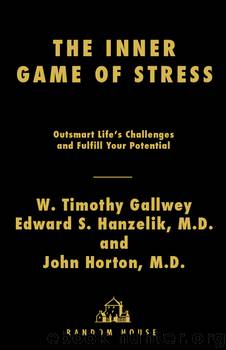The Inner Game of Stress by W. Timothy Gallwey

Author:W. Timothy Gallwey [Gallwey, W. Timothy]
Language: eng
Format: epub, mobi
ISBN: 978-1-58836-895-9
Publisher: Random House Publishing Group
Published: 2009-08-29T04:00:00+00:00
LEARNING TO CHANGE DESTABILIZING HABITS
Building your personal shield has a lot to do with changing unconscious habits. We all have our ways of changing, and it can be said we are constantly changing, like it or not. But conscious change is more powerful.
I remember that when I was a little kid, I was a thumb sucker. And when I was five, I decided I was going to stop sucking my thumb. My older sister said, “Thumb sucking can be really hard to change. It’s been a habit for a long time.” I looked at her and said, “Why should it be hard? It’s my hand. My thumb. And I put it into my mouth. So I can take it out of my mouth if I want.” So I stopped sucking my thumb.
I wish I could have kept that simple understanding and courage. It’s very possible, when you think about it: You want to change? So change. It’s your hand.
Most habits have a reason for being formed in the first place. That reason may no longer apply for you, but it was there once. So before you set about changing a habit, it’s a good idea to check out where the habit came from, what purpose it served, and if it is still serving you in the best way. Here’s an approach I use: Once I’ve determined that I want to make a change, the first thing I have to do is grant myself mobility. Mobility is the ability to move toward your desired outcome. When people talk about being trapped by a bad habit, they complain, “It’s just too hard to change.” But is that really true? Perhaps it’s hard to break a deeply ingrained habit; it can be like digging your way out of a ditch. But an alternative strategy, which works well, is to leave the old habit and start a new one. In other words, focus on what you want to be doing, instead of what feels wrong. This perspective has the same effect as a shield. It doesn’t require you to undo what’s wrong, just to do what feels right.
The first time I learned this—profoundly—I was coaching Joe, the CEO of a large company, in tennis. He announced at the start that he wanted to change the bad habit he had with his backhand.
“On my backswing, I think my racquet is too high,” he stated, before even going to the court. “I put backspin on the ball, and it tends to float out.”
I was curious. “How do you know your racquet is too high?” I asked him.
“Well,” he replied, “the last twelve pros I’ve been to have all told me the same thing.” I almost couldn’t believe my ears. He’d been to twelve pros, and I was number thirteen. Not a very auspicious beginning!
I asked him to take a swing where we were standing. He did, and I saw that the twelve pros were correct. He had accurately described his problem. But I was thinking, “If
Download
The Inner Game of Stress by W. Timothy Gallwey.mobi
This site does not store any files on its server. We only index and link to content provided by other sites. Please contact the content providers to delete copyright contents if any and email us, we'll remove relevant links or contents immediately.
Tools of Titans by Timothy Ferriss(8218)
Change Your Questions, Change Your Life by Marilee Adams(7635)
Deep Work by Cal Newport(6879)
Man-made Catastrophes and Risk Information Concealment by Dmitry Chernov & Didier Sornette(5921)
Playing to Win_ How Strategy Really Works by A.G. Lafley & Roger L. Martin(5917)
Digital Minimalism by Cal Newport;(5664)
Big Magic: Creative Living Beyond Fear by Elizabeth Gilbert(5610)
The Slight Edge by Jeff Olson(5346)
Ego Is the Enemy by Ryan Holiday(5294)
The Motivation Myth by Jeff Haden(5156)
Stone's Rules by Roger Stone(5026)
The Laws of Human Nature by Robert Greene(4997)
Tuesdays with Morrie by Mitch Albom(4690)
Eat That Frog! by Brian Tracy(4434)
Rising Strong by Brene Brown(4377)
Skin in the Game by Nassim Nicholas Taleb(4162)
Bullshit Jobs by David Graeber(4094)
The Money Culture by Michael Lewis(4076)
Skin in the Game: Hidden Asymmetries in Daily Life by Nassim Nicholas Taleb(3929)
